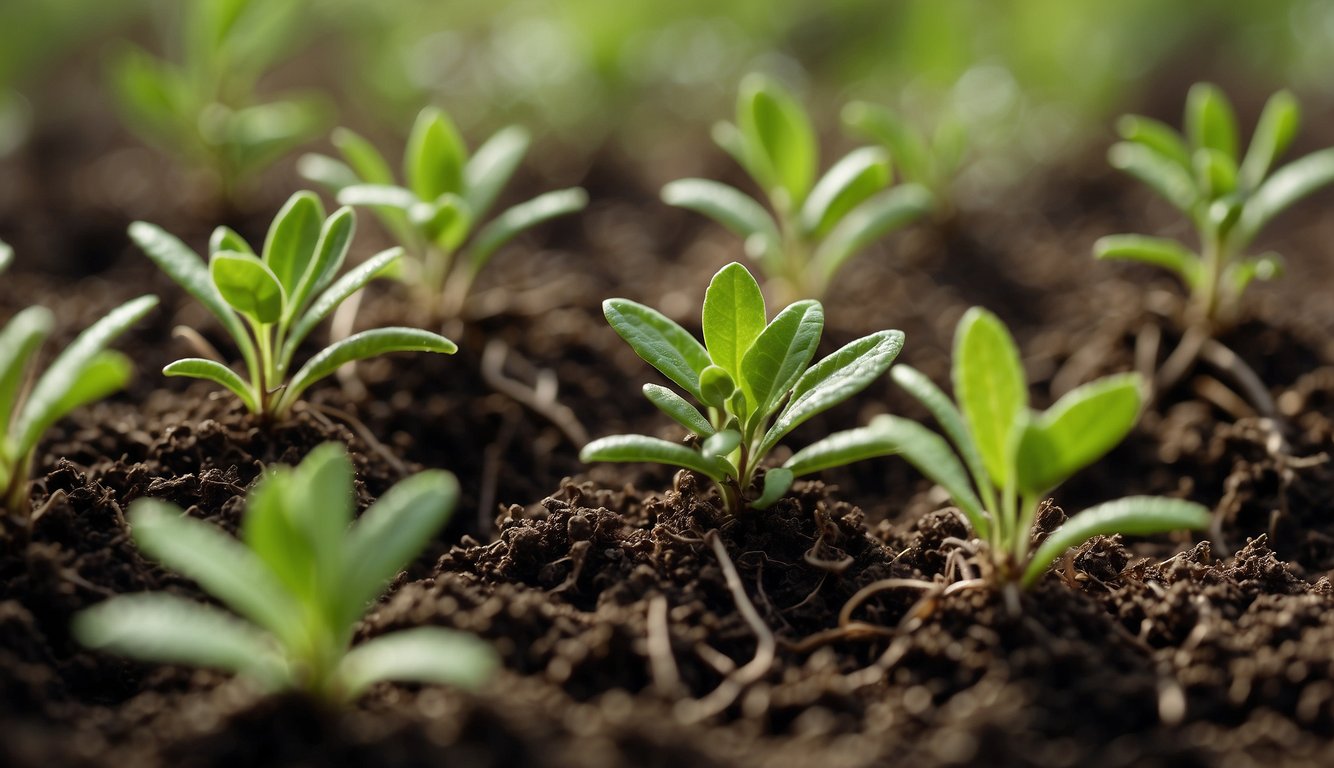TheHerbProf.com is a treasure trove of knowledge for those interested in natural healing and herbal remedies. The website is run by Paul Johnston MD. A naturopathic who has not only received extensive education in the field but also has personal experience in self-healing.
Grow thyme from cuttings is an easy and cost-effective way to expand your herb garden. Not only is thyme a versatile herb that can be used in a variety of dishes, but it also has many health benefits. Thyme contains antioxidants and has antibacterial properties, making it a useful herb to have on hand.
If you’re looking to grow thyme from cuttings, there are a few things you should know. First, it’s important to choose a healthy donor plant. Look for a plant that is disease-free and has plenty of foliage. Second, make sure to take cuttings from the donor plant that are at least 2 inches long. This will ensure that the cutting has enough stem to grow roots. Finally, it’s important to provide the cutting with the right growing conditions, including plenty of light and well-draining soil.
With the right care, your thyme cuttings should begin to grow roots within a few weeks. Once the roots are established, you can transplant the cutting into a larger pot or into your garden. By growing thyme from cuttings, you can enjoy fresh, flavorful herbs all year round.
Understanding Thyme – Grow Thyme from Cuttings
Thyme is a popular herb that is used in many culinary dishes. It is a member of the mint family and is native to the Mediterranean region. Thyme is known for its strong aroma and is often used to add flavor to soups, stews, and sauces. In this section, I will discuss the different varieties of thyme and the benefits of growing thyme.
Thyme Varieties – Grow Thyme from Cuttings
There are over 400 different varieties of thyme, but the most common variety is Thymus vulgaris. This variety is also known as common thyme or garden thyme. Other popular varieties include lemon thyme, orange thyme, and creeping thyme. Each variety has its own unique flavor and aroma.
Benefits of Growing Thyme
Growing thyme has many benefits. First and foremost, it is a great culinary herb that can be used to add flavor to a variety of dishes. Thyme is also a hardy plant that is easy to grow and maintain. It is a perennial plant, which means that it will come back year after year. Thyme is also a Mediterranean herb, which means that it is well-suited to hot, dry climates.
In addition to its culinary uses, thyme has many health benefits. It is rich in antioxidants and has anti-inflammatory properties. Thyme has also been used for centuries as a natural remedy for coughs and colds. It is also believed to have antibacterial and antifungal properties.
Thyme is a versatile herb that is easy to grow and has many culinary and health benefits. Whether you are a seasoned gardener or a beginner, thyme is a great plant to add to your garden.
Propagation Basics – Grow Thyme from Cuttings

What Are Cuttings?
Cuttings are a method of plant propagation where a piece of a plant is cut and planted to grow into a new plant. This is a common method used to propagate perennial herbs like thyme. Cuttings can be taken from both softwood and hardwood stems, but for thyme, it is best to take softwood cuttings in the spring or summer. Softwood cuttings are taken from the new growth of the plant and are more likely to root successfully.
Best Time to Propagate Thyme
The best time to propagate thyme is in the spring or summer. This is when the plant is actively growing and producing new shoots. It is important to take cuttings from healthy plants that are free from disease and pests. Cuttings should be taken from the new growth of the plant, as these are more likely to root successfully. It is also important to take several cuttings to increase the chances of success.
Once the cuttings have been taken, they should be planted in a well-draining potting mix and kept moist but not overly wet. It is also important to keep the cuttings in a warm, bright location, but out of direct sunlight. Rooting hormone can be used to increase the chances of success, but it is not necessary.
Propagating thyme from cuttings is a simple and effective way to grow new plants. By following these basic propagation techniques, you can successfully grow thyme from cuttings and enjoy the benefits of this versatile herb.
Preparing for Propagation – Grow Thyme from Cuttings
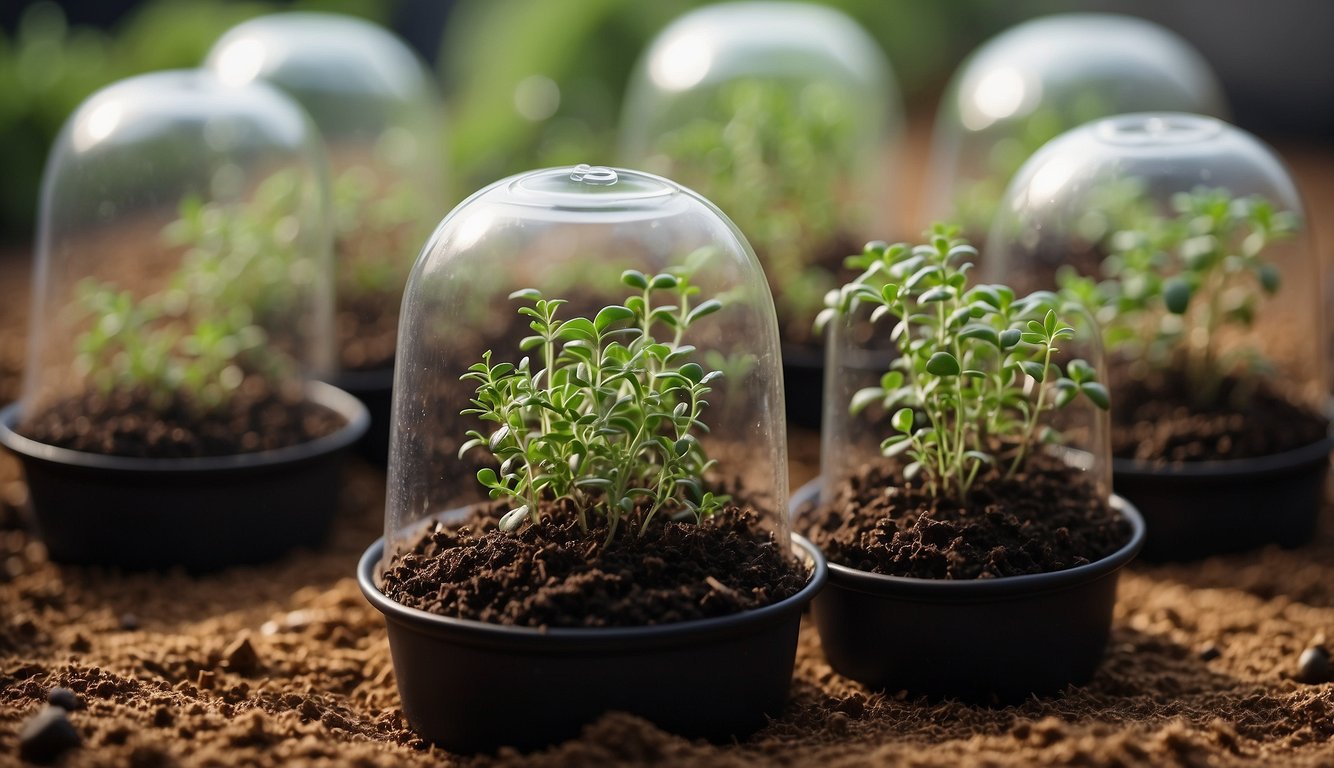
Growing thyme from cuttings is an easy and cost-effective way to propagate this herb. Before starting the propagation process, it is important to prepare properly to ensure the best chance of success. In this section, I will discuss the steps needed to prepare for thyme propagation.
Selecting the Right Cuttings – Grow Thyme from Cuttings
The first step in preparing for propagation is selecting the right cuttings. It is important to choose healthy, disease-free plants for propagation. The best time to take cuttings is in the spring or early summer when the plant is actively growing. Look for stems that are at least 3-4 inches long and have several sets of leaves.
When selecting cuttings, it is important to choose stems that are not too woody or too young. Woody stems may not root properly, while young stems may not have developed enough to root successfully. Additionally, it is important to select stems that have at least 2-3 sets of leaves, as this will provide the energy needed for the cutting to root.
Tools and Materials Needed
To prepare for propagation, you will need a few tools and materials. The following is a list of the items you will need:
- Shears: You will need a pair of sharp shears to cut the stems.
- Potting soil: Use a good quality potting soil to plant the cuttings.
- Rooting hormone: While not necessary, rooting hormone can help speed up the rooting process.
- Powder: If you choose to use rooting hormone, you will need the powder form.
- Natural rooting hormone: If you prefer a natural alternative to synthetic rooting hormone, you can use willow water or honey water.
- Containers: You will need small containers to plant the cuttings.
Before starting the propagation process, make sure you have all the necessary tools and materials on hand. This will ensure a smooth propagation process and increase the chances of success.
In the next section, I will discuss how to take cuttings from a thyme plant.
The Propagation Process – Grow Thyme from Cuttings
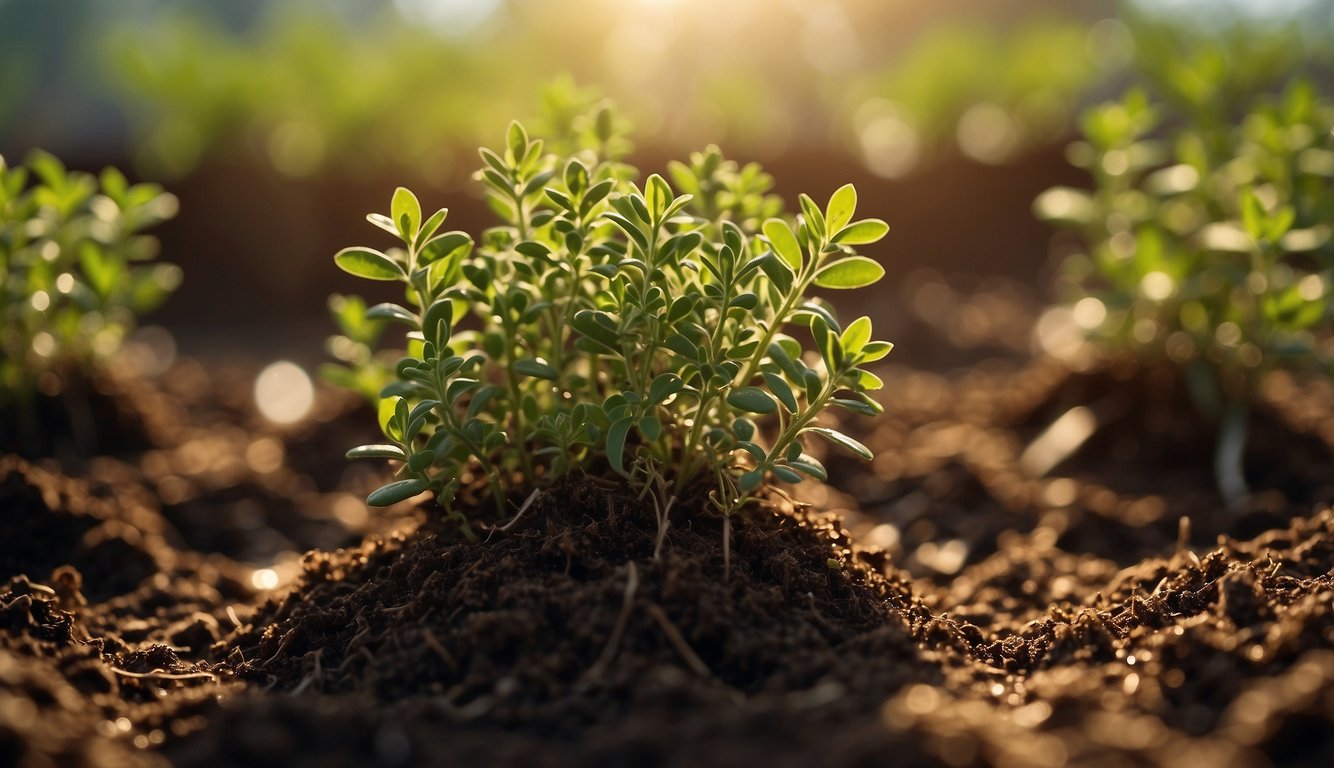
Growing thyme from cuttings is an easy and cost-effective way to expand your herb garden. In this section, I will explain the propagation process step-by-step.
Cutting and Preparing Stems – Grow Thyme from Cuttings
First, select a healthy thyme plant that is at least six months old. Cut a 4-6 inch stem from the plant using a sharp and clean pair of scissors or pruning shears. Make sure the stem has several nodes, which are the points where leaves emerge from the stem. Remove the leaves from the lower two-thirds of the stem, leaving only a few leaves at the top. This will help the plant focus its energy on growing roots rather than maintaining leaves.
Rooting the Cuttings
Once you have prepared the stem, it’s time to root it. There are two methods for rooting thyme cuttings: water propagation and soil propagation.
For water propagation, fill a glass with water and submerge the stem in the water, making sure that the nodes are fully submerged. Place the glass in a warm and bright location, away from direct sunlight. Change the water every 2-3 days to prevent the growth of bacteria. After 2-3 weeks, you should see roots growing from the nodes.
For soil propagation, dip the cut end of the stem in rooting hormone and plant it in a pot filled with well-draining soil. Make sure the soil is moist but not waterlogged. Cover the pot with a plastic bag to create a humid environment that will encourage root growth. Place the pot in a warm and bright location, away from direct sunlight. After 2-3 weeks, you should see roots growing from the nodes.
Propagating thyme from cuttings is an easy and rewarding process that allows you to expand your herb garden without spending a lot of money. Whether you choose water propagation or soil propagation, make sure to give your cuttings plenty of light, warmth, and moisture to help them thrive.
Caring for New Thyme Plants – Grow Thyme from Cuttings
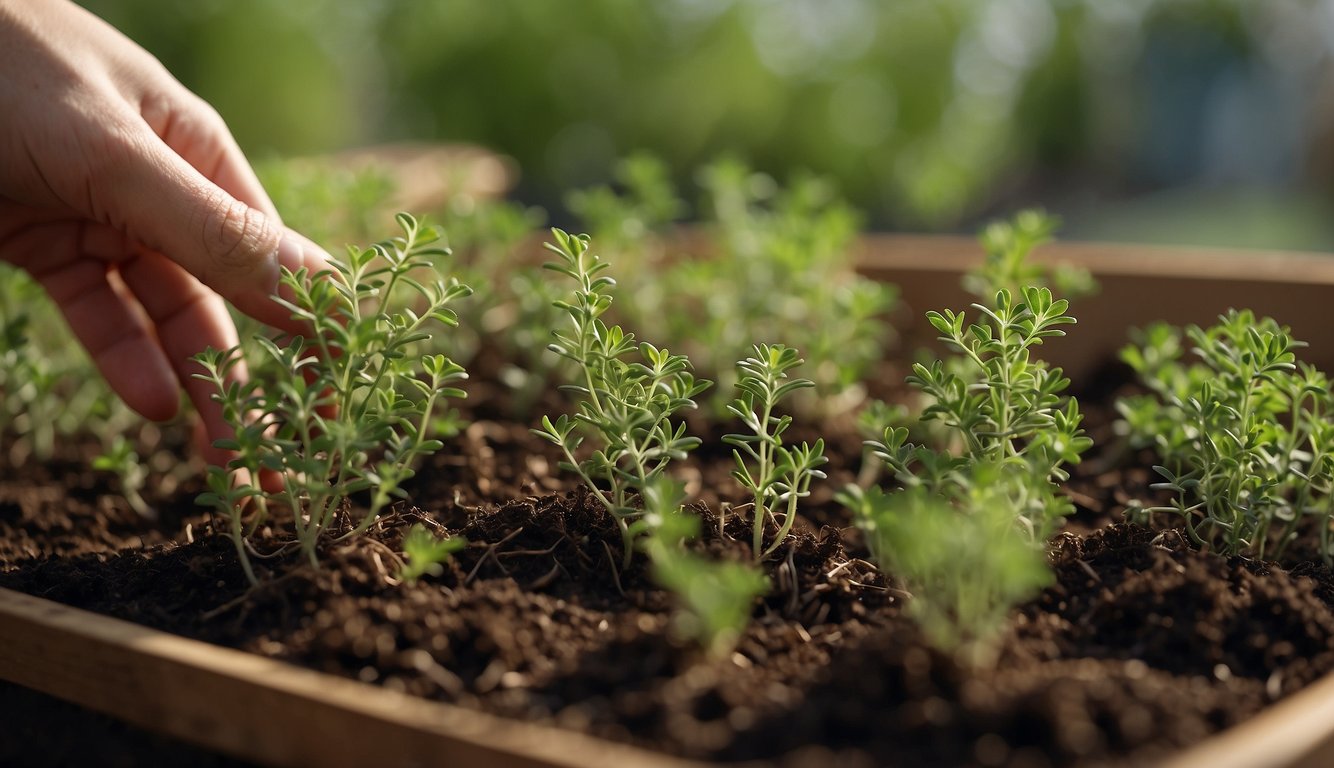
After successfully propagating thyme from cuttings, it is important to take proper care of your new plants to ensure their growth and survival. In this section, I will cover the watering and light requirements for thyme plants, as well as how to transplant them to pots or the garden.
Watering and Light Requirements – Grow Thyme from Cuttings
Thyme plants require moderate watering and full sun to grow well. It is important to keep the soil moist but not waterlogged, as thyme plants do not tolerate wet feet. I recommend watering the plants deeply once a week, allowing the soil to dry out slightly between waterings.
When it comes to light requirements, thyme plants need at least six hours of full sun per day. If you are growing thyme indoors, place the plants near a south-facing window or under grow lights to ensure they receive enough light.
Transplanting to Pots or Garden
If you started your thyme cuttings in a small pot, you will need to transplant them to a larger container or the garden once they outgrow their current home. When transplanting, make sure to choose a pot with good drainage and use a well-draining potting mix to prevent water from accumulating at the bottom of the pot.
To transplant the thyme, gently remove it from its current pot and loosen the roots. Dig a hole in the new pot or garden bed that is slightly larger than the root ball, and place the thyme in the hole. Backfill the hole with soil, pressing down firmly to remove any air pockets.
After transplanting, water the thyme deeply and monitor it closely for signs of transplant shock, such as wilting or yellowing leaves. With proper care, your new thyme plants should thrive and provide you with fresh herbs for years to come.
Common Challenges and Solutions – Grow Thyme from Cuttings

Growing thyme from cuttings is a great way to propagate this herb and enjoy its fresh flavor in your cooking. However, there are some common challenges that you may face when trying to grow thyme from cuttings. In this section, I will discuss some of these challenges and provide solutions to help you overcome them.
Dealing with Pests and Diseases – Grow Thyme from Cuttings
One of the most common challenges when growing thyme from cuttings is dealing with pests and diseases. Thyme plants are susceptible to a number of pests, including spider mites, aphids, and thrips. These pests can cause damage to the leaves and stems of the plant, which can affect its growth and overall health.
To prevent pests from infesting your thyme plants, it is important to keep them healthy and well-maintained. This includes regular watering, fertilizing, and pruning. You can also use natural pest control methods, such as neem oil or insecticidal soap, to keep pests at bay.
In addition to pests, thyme plants are also susceptible to a number of diseases, including root rot and powdery mildew. These diseases can cause the plant to wilt, turn yellow, or even die.
To prevent diseases from affecting your thyme plants, it is important to provide them with proper care and maintenance. This includes regular watering, good air circulation, and proper drainage. You can also use fungicides or other disease control products to prevent the spread of disease.
Preventing Root Rot and Shock
Another common challenge when growing thyme from cuttings is preventing root rot and shock. Root rot can occur when the plant is overwatered or planted in soil that does not drain well. Shock can occur when the plant is transplanted or moved from one location to another.
To prevent root rot and shock, it is important to provide your thyme plants with proper care and maintenance. This includes using well-draining soil, watering the plant only when the soil is dry, and avoiding over-fertilizing. When transplanting or moving your thyme plant, be sure to do so carefully and gradually to avoid shock.
By following these tips and providing your thyme plants with proper care and maintenance, you can overcome the common challenges of growing thyme from cuttings and enjoy a healthy, mature plant that produces fresh and flavorful herbs for your cooking.
Harvesting and Using Thyme – Grow Thyme from Cuttings

Thyme is a versatile herb that can be used in both culinary and medicinal applications. Growing thyme from cuttings is a great way to ensure a fresh supply of this herb. In this section, I will discuss when and how to harvest thyme and its culinary and medicinal uses.
When and How to Harvest – Grow Thyme from Cuttings
Thyme can be harvested at any time during the growing season, but it is best to harvest it just before it flowers. This is when the leaves contain the highest concentration of essential oils, which give thyme its flavor and aroma. To harvest thyme, simply snip off the top 4-6 inches of the stem, making sure to leave a few inches of stem below the cut.
Thyme can be harvested fresh or dried. To dry thyme, simply tie the stems together and hang them upside down in a warm, dry place for several days. Once the leaves are dry, they can be removed from the stems and stored in an airtight container.
Culinary and Medicinal Uses
Thyme is a popular culinary herb that is used to flavor meats, fish, sauces, stews, and more. It has a slightly sweet, earthy flavor that pairs well with a variety of dishes. Fresh thyme is best for culinary applications, as it has a more potent flavor than dried thyme.
In addition to its culinary uses, thyme also has several medicinal properties. It is a natural antiseptic and can be used to treat coughs, colds, and sore throats. Thyme tea is a popular remedy for respiratory ailments, and thyme oil is often used in aromatherapy to relieve stress and anxiety.
Overall, thyme is a versatile and useful herb that can be easily grown from cuttings. Whether you are using it in the kitchen or for medicinal purposes, fresh thyme is a valuable addition to any herb garden.
Advanced Propagation Techniques – Grow Thyme from Cuttings

Layering and Division – Grow Thyme from Cuttings
In addition to growing thyme from cuttings, there are two other advanced propagation techniques that can be used to increase your thyme plant collection. One technique is called layering, which involves bending a low-growing thyme stem to the ground and covering it with soil. Once the stem has rooted, it can be cut from the parent plant and transplanted to a new location. This method is particularly useful for propagating thyme plants that are difficult to root from cuttings.
Another technique is dividing an established thyme plant. This can be done by digging up the plant and separating the root ball into sections, each containing a portion of the plant stem and roots. Each section can then be replanted in a new location. This method is useful for rejuvenating an older thyme plant or for propagating a large number of plants at once.
Growing Thyme with Companion Plants
Thyme is a member of the mint family and can be grown alongside other herbs such as basil, sage, and oregano. These herbs have similar growing requirements and can be planted together in the same container or garden bed. In addition, thyme can also be grown with lavender and tomatoes.
When planting thyme with other herbs, it is important to consider the growth habits of each plant. For example, thyme is a low-growing plant, while basil and oregano are taller and bushier. To prevent overcrowding, it is important to space the plants accordingly.
Layering and division are advanced propagation techniques that can be used in addition to growing thyme from cuttings. Thyme can also be grown with other herbs such as basil, sage, and oregano, as well as lavender and tomatoes. By using these techniques and companion planting, you can increase your thyme plant collection and create a beautiful and functional herb garden.
Long-Term Thyme Care – Grow Thyme from Cuttings

As a perennial herb, thyme can provide a steady supply of fresh leaves for cooking and other uses for years. However, it requires some maintenance and care to keep it healthy and productive.
Pruning and Maintenance – Grow Thyme from Cuttings
Pruning is an essential part of thyme care. Regularly trimming back the plant helps to promote new growth and keep it from becoming too woody. I like to trim my thyme back by a third in the spring and again in the fall. This encourages new growth and helps to keep the plant from becoming too leggy.
Thyme is an evergreen plant, which means it will continue to grow throughout the year. However, it may slow down during the winter months. To keep it healthy, it’s important to water it regularly and avoid letting it dry out completely.
Seasonal Considerations
When it comes to seasonal considerations, there are a few things to keep in mind. Thyme is a hardy plant that can survive in a range of temperatures, but it prefers a warm and dry climate. If you live in an area with cold winters, you may want to consider covering your thyme with a layer of mulch to protect it from frost.
Thyme also prefers a slightly alkaline soil with a pH between 7.0 and 8.0. If your soil is too acidic, you can add some lime to raise the pH. If you’re not sure about the pH of your soil, you can get a soil test kit from a garden center or nursery.
There are several varieties of thyme, including common thyme, English thyme, and creeping thyme. Each variety has its own unique characteristics and uses. Common thyme is the most popular variety and is often used in cooking. English thyme has a more delicate flavor and is often used in teas and potpourris. Creeping thyme is a low-growing variety that is often used as a ground cover.
Thyme is a versatile and easy-to-grow herb that can provide a steady supply of fresh leaves for years. With a little bit of care and maintenance, you can enjoy the benefits of this delicious herb for seasons to come.
Time for Thyme: Grow Thyme from Cuttings
Today, we’re stepping into the fragrant world of growing thyme from cuttings!
Now, thyme is a wonderful herb. It’s aromatic, flavorful, and a joy to grow. But did you know you can grow it from cuttings? That’s right, folks!
You see, growing thyme from cuttings is a fun and easy way to expand your herb garden. It’s like making a clone of your favorite thyme plant!
But here’s the kicker. The key to successful propagation is a healthy cutting. So, choose a strong, healthy stem from your thyme plant for the best results.
And don’t forget, patience is key. It might take a few weeks for your cutting to develop roots. But trust me, it’s worth the wait!
So, if you’re ready to try your hand at growing thyme from cuttings, head over to theherbprof.com. It’s packed with tips and tricks to help you on your gardening journey.
Remember, folks, gardening is not just about growing plants. It’s about growing joy, one cutting at a time. So, let’s keep planting, keep growing, and keep laughing. Happy gardening!
References – Grow Thyme from Cuttings
Little Herb Encyclopedia, by Jack Ritchason; N.D., Woodland Publishing Incorporated, 1995
The Ultimate Healing System, Course Manual, Copyright 1985, Don Lepore
Planetary Herbology, Michael Tierra, C.A., N.D., Lotus Press, 1988
Handbook of Medicinal Herbs, by James A. Duke, Pub. CRP Second Edition 2007
The Complete Medicinal Herbal, by Penelope Ody, Published by Dorling Kindersley
Check the Following Articles!
Flies in Compost Bin: What Can You Do About It?
Neem Oil Soil Drench: Benefits and Application Guide
Growing Herbs in Pots Outdoors: Bountiful Harvest Tips
Frequently Asked Questions – Grow Thyme from Cuttings
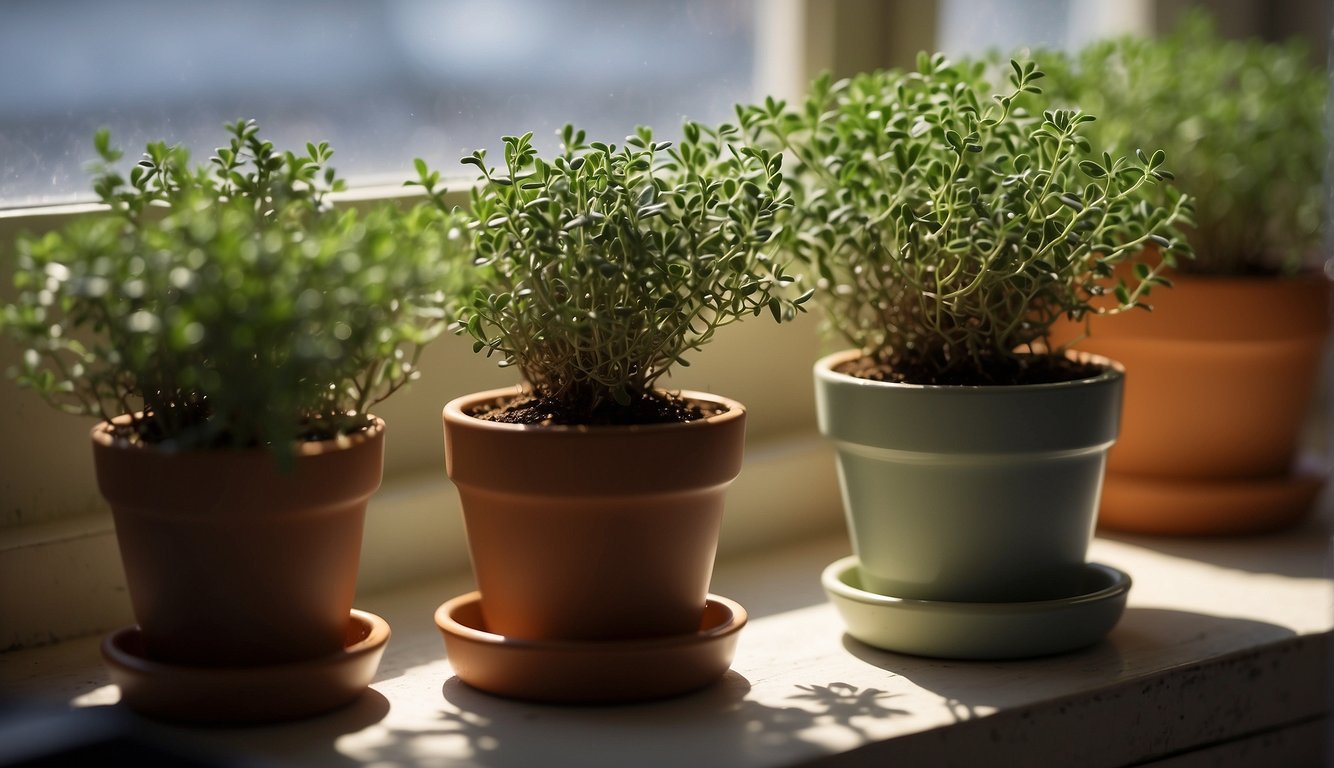
What are the steps to propagate thyme in water?
To propagate thyme in water, cut a 4- to 6-inch stem from an established thyme plant, remove any leaves from the bottom half of the stem, and place the cutting in a glass of water, making sure that the bottom of the stem is submerged. Change the water every two days to keep it fresh and prevent bacterial growth. After 2-3 weeks, roots should begin to grow, and the cutting can be transplanted into soil.
How can I successfully grow thyme indoors after propagation?
To successfully grow thyme indoors after propagation, make sure to plant the cutting in well-draining soil and place it in a location that receives at least 6 hours of sunlight per day. Keep the soil moist but not overly saturated, and fertilize the plant every 2-3 weeks with a balanced fertilizer.
Is it possible to cultivate thyme from store-bought stems?
Yes, it is possible to cultivate thyme from store-bought stems. Simply follow the same steps for propagating thyme from cuttings, and make sure to choose stems that are healthy and free from disease.
What is the process for propagating creeping thyme effectively?
To propagate creeping thyme effectively, take cuttings from the plant in late spring or early summer, when the plant is actively growing. Cut the stem just below a leaf node, and remove the leaves from the bottom half of the stem. Plant the cutting in well-draining soil, and keep it moist but not overly saturated. After 2-3 weeks, roots should begin to grow, and the cutting can be transplanted into its permanent location.
Does thyme have the ability to regenerate after being cut for propagation?
Yes, thyme has the ability to regenerate after being cut for propagation. In fact, regular pruning of thyme can encourage new growth and help keep the plant healthy.
What techniques are used for layering thyme to encourage root development?
To layer thyme to encourage root development, choose a low-growing stem that is close to the ground. Remove the leaves from the bottom half of the stem, and make a small cut in the stem just below a leaf node. Bury the cut portion of the stem in soil, leaving the top portion of the stem exposed. Keep the soil moist but not overly saturated, and after 2-3 weeks, roots should begin to grow from the buried portion of the stem.
